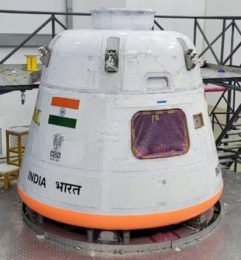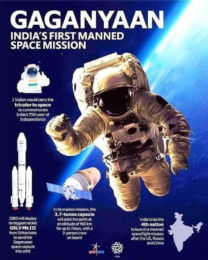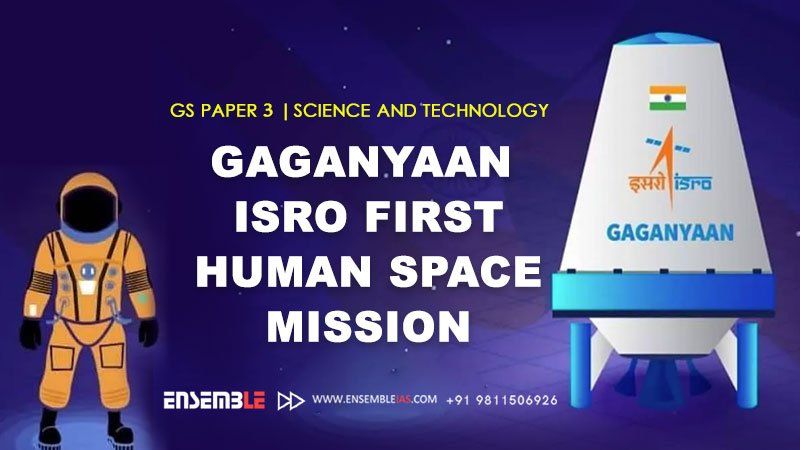Gaganyaan’s ISRO first human space mission
Why Gaganyaan in the News?
Gaganyaan 1st test module was launched on Saturday and completed the mission successfully from Sriharikota by ISRO.
- Test Vehicle Flight TV-D1’s purpose was to test and demonstrate astronauts’ escape and safety mechanisms.
- ISRO plans to launch the Gaganyaan’s series with a live human mission after the success of TV-D1.
- No live humans were present on the TV-D1 on Saturday.
- As per the ISRO chief Test Vehicle (TV-D1) was supposed to lift off at 8 AM but was postponed due to weather and technical glitches from Sriharikota.
- It is one of the biggest and most critical missions launched by ISRO in collaboration with the Indian Navy.

What is the Gaganyaan – 3 mission?
- Gaganyaan’s is the first man-made mission or 1st human space mission.
- ISRO’s ultimate goal is to launch humans into space, place them in a 400-kilometer Low Earth Orbit on a three-day Gaganyaan’s mission, and bring them back to Earth without incident.
- For the Gaganyaan’s mission, a human-rated LVM-3 rocket will be used, with the Orbital Module being transported to a 400 km low Earth orbit. The Crew Module, on the other hand, is an unpressurized variant for the Test Vehicle Abort Mission 1 (TV-D1), matching the size and weight of the actual Crew Module intended for the Gaganyaan’s mission. It has a set of parachutes as well as deceleration and recovery systems.
- Gaganyaan’s 1st test module was launched on Saturday from Sriharikota by ISRO. The mission includes four test flights, including two uncrewed flights and one with a humanoid robot.
- First Test Vehicle Flight TV-D1 was launched on Saturday with no human presence including the purpose of testing and demonstrating astronauts’ escape and safety mechanisms.
- As per ISRO chief S. Somnath, the Test Vehicle (TV-D1) was supposed to lift off at 8 AM but was postponed due to weather and technical glitches from Sriharikota.
- The second test flight, dubbed Flight Test Vehicle Abort Mission-2 (TV-D2), will take place in 2024 and will be used to evaluate orbital module and re-entry technologies. The third test flight, dubbed Flight Test Vehicle Abort Mission-3 (TV-D3), will take place in 2024, with a humanoid robot named Vyommitra performing human tasks and communicating with the ground station. Test Vehicle Abort Mission-4 (TV-D4), the fourth and final test mission, will be launched in 2025 with three astronauts on board.
The link to join the course : Online Courses

TV-D1 – Test Vehicle Demonstration or Test Vehicle Abort Mission-1
- The first flight mission of a test vehicle uses The Crew Module (CM) and Crew Escape System (CES) installed at the front of the liquid-propelled, single-stage test vehicle, which is powered by a modified VIKAS engine.
- To demonstrate Test Vehicle sub-systems & safety features and an escape system for astronauts.
- ISRO has used a low-cost rocket due to test flight.
Crew-Module
- The Gaganyaan’s program’s crew module is an essential part of the spacecraft that will house the astronauts.
- To protect astronauts in space, the crew module is built with life support systems, is heat-resistant, and has an aerodynamic design.
- Additionally, it has systems and safety precautions for possible emergencies. During their trip, astronauts will reside and work in this section of the spacecraft.
- The crew- module is an aluminium construction with a single wall and a mock thermal protection system. Its dimensions (3.1 m × 2.97 m) and weight (4,520 kg) are identical to those of the module being designed for human flight.
CES: – A vital emergency escape route for human space missions is the crew escape system, sometimes referred to as the launch escape system or the launch abort system. Its purpose is to separate the astronauts’ carrying crew module from the launch rocket. In the event of mission-threatening problems, it immediately activates and quickly ejects the crew, particularly in the turbulent early ascent. A crew escape system’s main goal is to quickly and safely extract the crew from the spaceship in the event of an anomaly during launch or ascent, such as a malfunctioning rocket or other situations that could put the astronauts’ lives in danger.
Water Survival Test Facility (WSTF)
The Indian Navy runs a cutting-edge facility called the WSTF. Astronauts and cosmonauts can practice water survival and training at the Water Survival Test Facility (WSTF), a specialist facility. To make sure that the crew is ready for any situation they may experience, it may replicate any sea conditions, environmental considerations, time of day, and other pertinent parameters.
Low Earth orbit (LEO)
Low Earth orbit (LEO) is a region of space that extends from approximately 180 kilometres (112 miles) to nearly 2,000 kilometres (1,243 miles) above the Earth’s surface. LEO is one of several orbital areas in which things such as satellites and spacecraft can be deployed. LEO is a popular location for satellite missions such as weather monitoring, Earth imagery, scientific research, and even human spaceflight. The International Space Station (ISS) orbits the Earth in LEO, as do many commercial satellite constellations, such as those used for global internet coverage.
Vyommitra
Is a combination of the Sanskrit words “Vyoma,” which means “space” or “sky,” and “Mitra,” which means “friend” or “companion.” It is a humanoid robot developed by the Indian Space Research Organisation (ISRO) for use in human spaceflight missions. Vyommitra is intended to help astronauts on board spacecraft and during space missions such as Gaganyaan’s by monitoring and responding to the environment, interacting with astronauts, and delivering information.
Impact
The mission will increase India’s scientific and technological capabilities, and contribute to global space cooperation while increasing India’s status and providing social and economic advantages. The Gaganyaan’s mission will encourage young people to pursue jobs in science, technology, engineering, and mathematics (STEM). The Gaganyaan’s mission will provide India with social and economic benefits such as job creation, improved education, health care, agriculture, disaster management, and environmental protection. India will be the fourth country to launch a human into space, following the Soviet Union, the United States, and China.
Conclusion
The Gaganyaan’s mission is a source of pride for India and inspiration for the rest of the globe. This mission is a dream realized for India and a beacon of hope for humanity.
Best Online Coaching for Civil Service_IAS_ UPSC_IFS_IPS
Free Study Material ENSEMBLE IAS ACADEMY | Call +91 98115 06926 |
Visit us: – https://ensembleias.com/ | Online Store: https://online.ensemble.net.in/
#ISRO #gaganyaan #Narendermodi #AV-D1 #S_Somnath #Science #goals #explorepage #Lifestyles #services_study #ensemble_ias_academy #geography_optional #k_siddharthasir #ias #upsc_exam #civilservices #upsc_motivation #upsc_aspirants #trendsingeography #lowearthorbit #gaganyaanmissionsuccess




